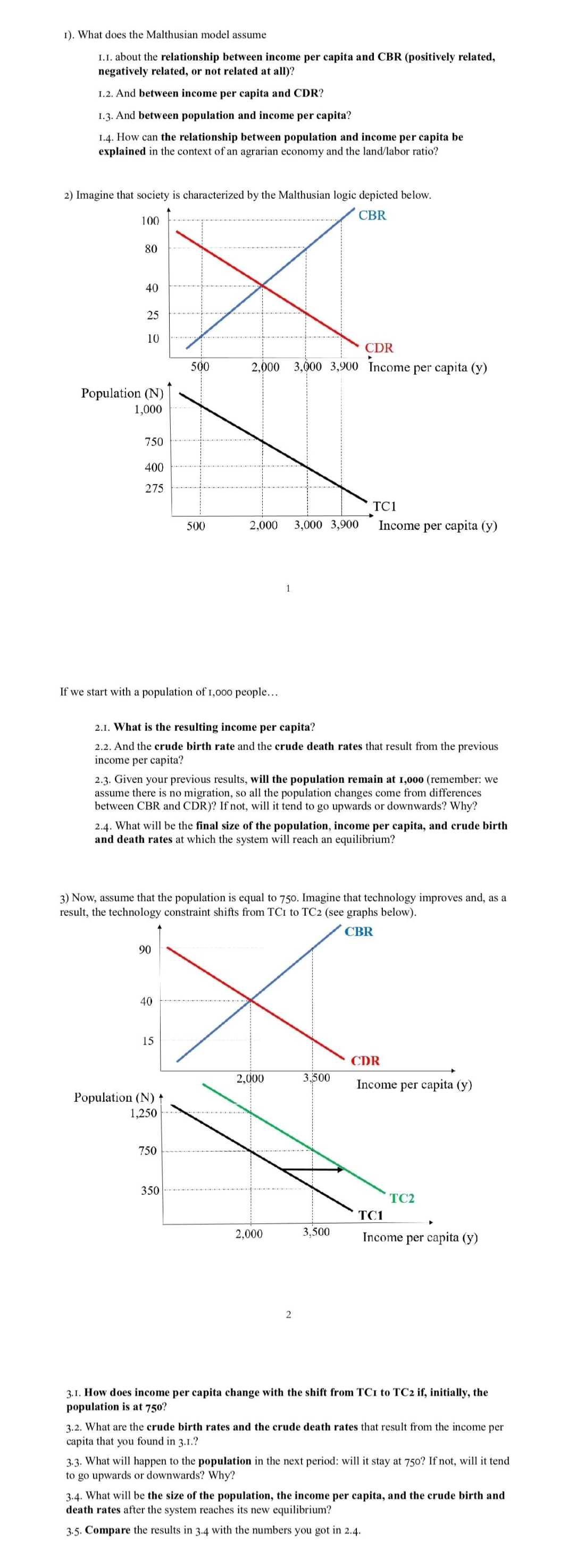1). What does the Malthusian model assume I.I. about the relationship between income per capita and CBR (positively related, negatively related, or not related at all)? 1.2. And between income per capita and CDR? 1.3. And between population and income per capita? 1.4. How can the relationship between population and income per capita be explained in the context of an agrarian economy and the land/labor ratio? 2) Imagine that society is characterized by the Malthusian logic depicted below. CBR 100 80 40 25 10 CDR 500 2,000 3,00 3,900 Income per capita (y) Population (N) 1,000 750 400
1). What does the Malthusian model assume I.I. about the relationship between income per capita and CBR (positively related, negatively related, or not related at all)? 1.2. And between income per capita and CDR? 1.3. And between population and income per capita? 1.4. How can the relationship between population and income per capita be explained in the context of an agrarian economy and the land/labor ratio? 2) Imagine that society is characterized by the Malthusian logic depicted below. CBR 100 80 40 25 10 CDR 500 2,000 3,00 3,900 Income per capita (y) Population (N) 1,000 750 400
Principles of Economics 2e
2nd Edition
ISBN:9781947172364
Author:Steven A. Greenlaw; David Shapiro
Publisher:Steven A. Greenlaw; David Shapiro
Chapter1: Welcome To Economics!
Section: Chapter Questions
Problem 26CTQ: Suppose, as an economist, you are asked to analyze an issue unlike anything you have ever done...
Related questions
Question
sub= 24 help

Transcribed Image Text:1). What does the Malthusian model assume
I.I. about the relationship between income per capita and CBR (positively related,
negatively related, or not related at all)?
1.2. And between income per capita and CDR?
1.3. And between population and income per capita?
I.4. How can the relationship between population and income per capita be
explained in the context of an agrarian economy and the land/labor ratio?
2) Imagine that society is characterized by the Malthusian logic depicted below.
CBR
100
80
40
25
10
CDR
500
2,000
3,000 3,900 Income per capita (y)
Population (N)
1,000
750
400
275
TC1
500
2,000
3,000 3,900
Income per capita (y)
1
If we start with a population of 1,000 people...
2.1. What is the resulting income per capita?
2.2. And the crude birth rate and the crude death rates that result from the previous
income per capita?
2.3. Given your previous results, will the population remain at 1,000 (remember: we
assume there is no migration, so all the population changes come from differences
between CBR and CDR)? If not, will it tend to go upwards or downwards? Why?
2.4. What will be the final size of the population, income per capita, and crude birth
and death rates at which the system will reach an equilibrium?
3) Now, assume that the population is equal to 750. Imagine that technology improves and, as a
result, the technology constraint shifts from TCI to TC2 (see graphs below).
CBR
90
40
15
CDR
2,000
3,500
Income per capita (y)
Population (N) ↑
1,250
750
350
TC2
TC1
2,000
3,500
Income per capita (y)
2
3.1. How does income per capita change with the shift from TC1 to TC2 if, initially, the
population is at 750?
3.2. What are the crude birth rates and the crude death rates that result from the income per
capita that you found in 3.1.?
3.3. What will happen to the population in the next period: will it stay at 750? If not, will it tend
to go upwards or downwards? Why?
3.4. What will be the size of the population, the income per capita, and the crude birth and
death rates after the system reaches its new equilibrium?
3.5. Compare the results in 3.4 with the numbers you got in 2.4.
Expert Solution
This question has been solved!
Explore an expertly crafted, step-by-step solution for a thorough understanding of key concepts.
This is a popular solution!
Trending now
This is a popular solution!
Step by step
Solved in 2 steps with 2 images

Knowledge Booster
Learn more about
Need a deep-dive on the concept behind this application? Look no further. Learn more about this topic, economics and related others by exploring similar questions and additional content below.Recommended textbooks for you

Principles of Economics 2e
Economics
ISBN:
9781947172364
Author:
Steven A. Greenlaw; David Shapiro
Publisher:
OpenStax

Principles of Economics (MindTap Course List)
Economics
ISBN:
9781305585126
Author:
N. Gregory Mankiw
Publisher:
Cengage Learning

Essentials of Economics (MindTap Course List)
Economics
ISBN:
9781337091992
Author:
N. Gregory Mankiw
Publisher:
Cengage Learning

Principles of Economics 2e
Economics
ISBN:
9781947172364
Author:
Steven A. Greenlaw; David Shapiro
Publisher:
OpenStax

Principles of Economics (MindTap Course List)
Economics
ISBN:
9781305585126
Author:
N. Gregory Mankiw
Publisher:
Cengage Learning

Essentials of Economics (MindTap Course List)
Economics
ISBN:
9781337091992
Author:
N. Gregory Mankiw
Publisher:
Cengage Learning

Principles of Economics, 7th Edition (MindTap Cou…
Economics
ISBN:
9781285165875
Author:
N. Gregory Mankiw
Publisher:
Cengage Learning

Brief Principles of Macroeconomics (MindTap Cours…
Economics
ISBN:
9781337091985
Author:
N. Gregory Mankiw
Publisher:
Cengage Learning